Earlier this year, we explored various embroidered tapestries from all over the world, focusing on how embroidery is used to tell stories.
We began by looking at the Prestonpans Tapestry in Scotland, and from there we explored tapestries of the World Wars and Heritage Tapestries.
Just as narrative poetry can relate the great epics of mythology and history, narrative embroidery can relate visually – in vivid, captivating detail – similar epics.
If you’ve ever contemplating starting a narrative tapestry, whether on a small scale (relating, for example, the story of your own family), or on a larger scale, perhaps relating the history of your city or town or region, then you definitely will be interested in The Art of Narrative Embroidery by Rosemary Farmer and Maggie Ferguson.
And heck, even if you never dream of creating a narrative piece of embroidery, if you love embroidery, history, bustling activity, people, places, animals, ships, incredible vistas – all worked with needle and thread – you’ll love this book!
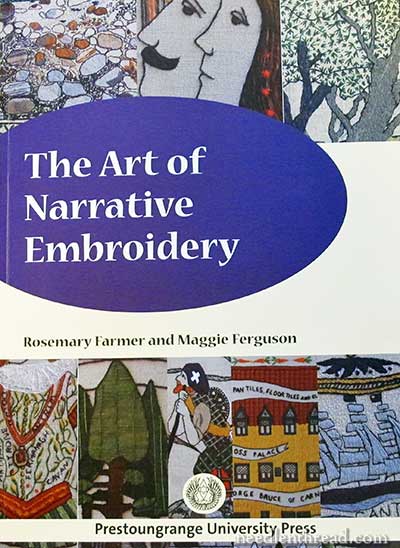
The Art of Narrative Embroidery, published by Prestoungrange University Press, is a narrative itself. It tells the story of the creation of two tapestries, really – the Battle of Prestonpans Tapestry and the Scottish Diaspora Tapestry.
What makes this particular book different from other instructional embroidery books is that it isn’t so much an instructional book in stitchery as it is a demonstration on how stitches can be used to produce these magnificent works of art.
What you’ll find among the pages is a vast resource of inspiration and ideas for how to make your stitches tell stories.
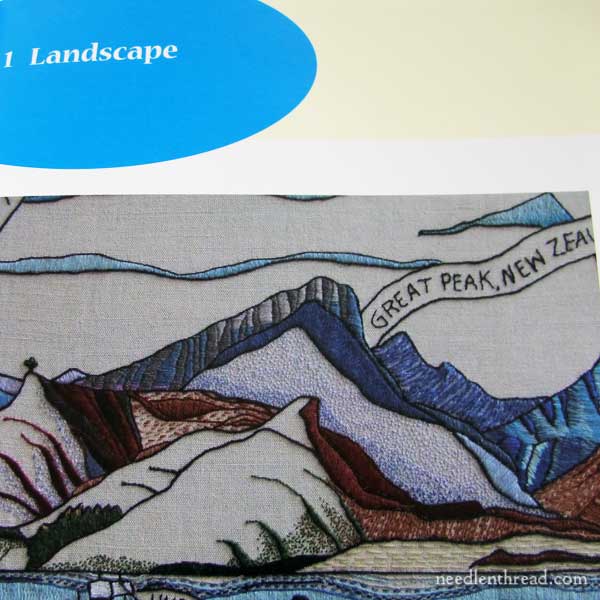
The book is loaded to the gills with detailed photos of the embroidered panels of both the Prestonpans Tapestry and the Scottish Diaspora Tapestry.
The photos are divided into eleven categories, and each category comprises a section of the book.
Landscapes kick off the book, because really, you can’t have a story without a setting! The landscapes are an essential part of the tapestry panels, and you’ll find in the photos all kinds of landscapes represented in stitchery, with detailed descriptions of how the particular landscape was worked and with what stitches.
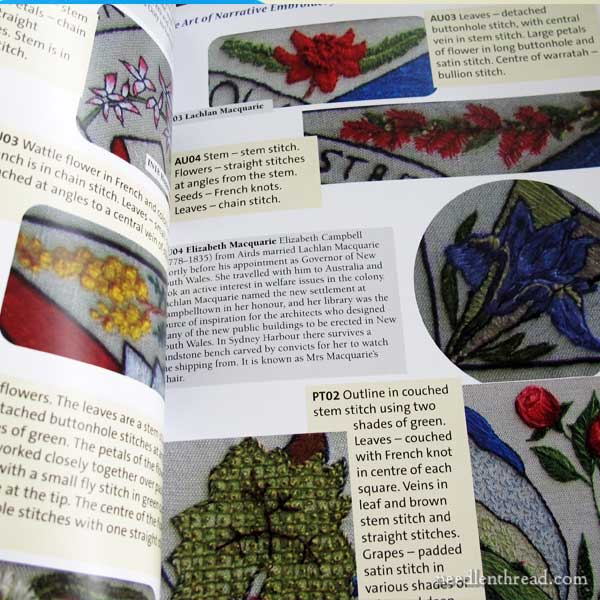
You’ll find close up photos of native flowers (not just native to Scotland, though a good amount of thistles do show up!), of leaves, vines, trees and the like included under landscape, too.
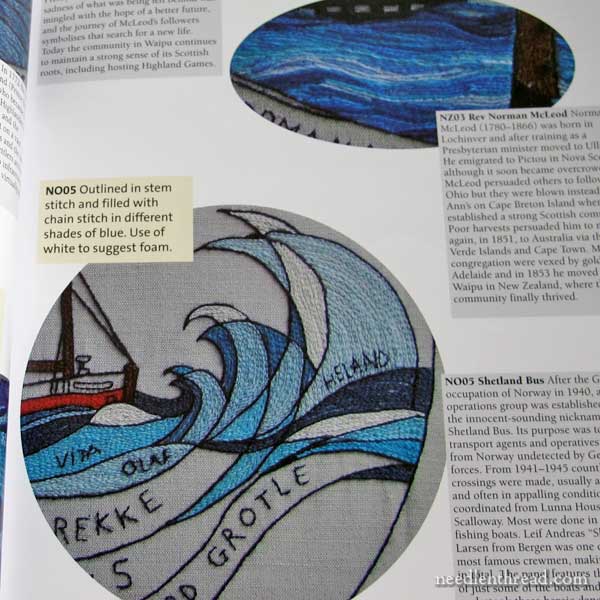
I’m pretty sure you couldn’t tell any story of Scotland without mention of the sea, and so seascapes figure in as well – and some of them are just glorious!
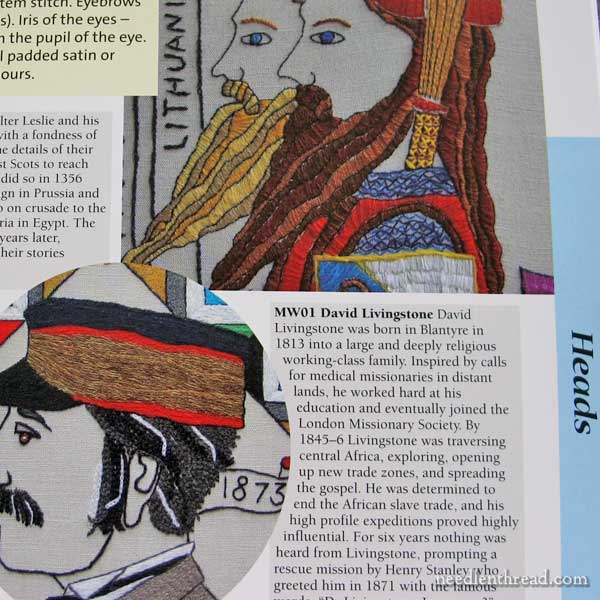
Heads follow landscapes. The great stories of history, after all, are about people, so people figure into the tapestries abundantly.
Detailed descriptions of the people, who they are, where there are on the particular tapestries, and how they were brought to life in stitchery are all included. And it all makes fascinating reading!
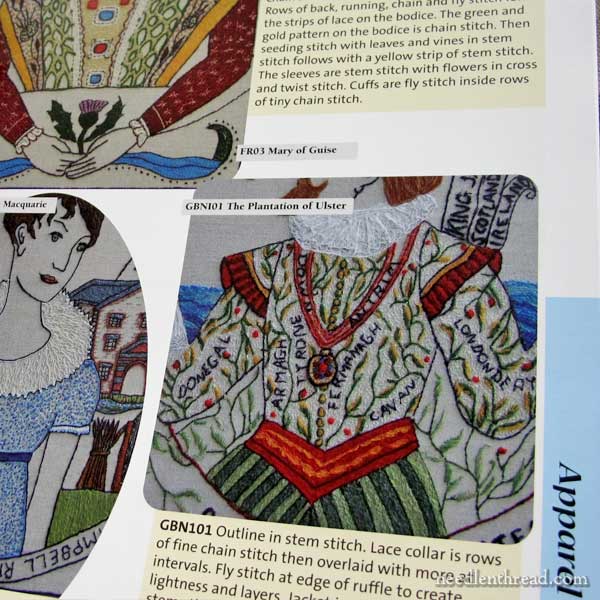
And of course, the people are pretty much clothed, so the next section is on apparel.
And oh, golly, talk about vivid, expressive, and sometimes motley – this section of the book is downright fun! The embroiderers went to town on the apparel, using the clothing as a springboard for some exquisite creativity.
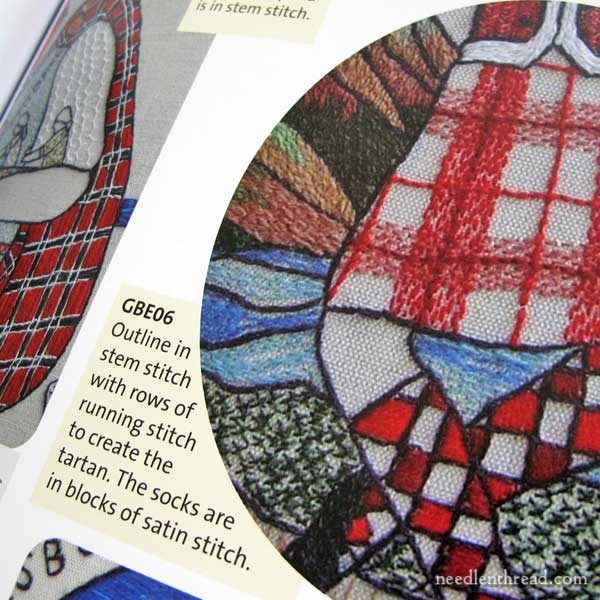
And, being Scottish tapestries, there’s no wonder plaid figures into the apparel… a lot!
There’s no dearth of plaid in the book, so if you’ve got a thing for tartans and have always wanted to stitch up your own little clan figures knocking their heels together in a bit of a reel, you’ll find all kinds of ways to embroider plaids in this book!
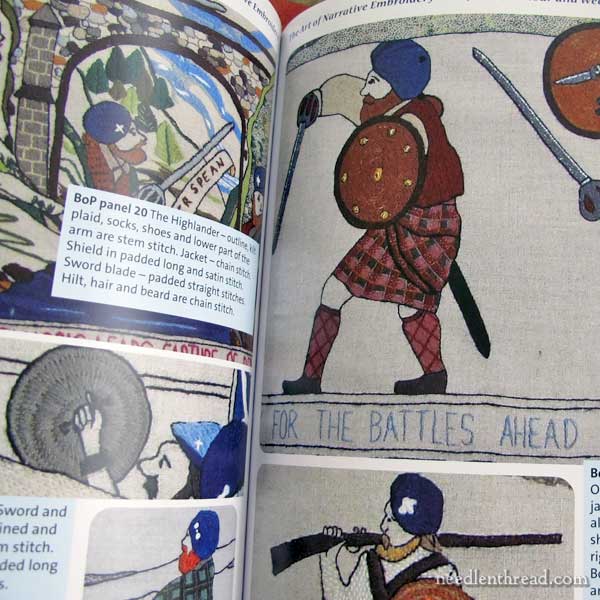
After the section on apparel, there’s a small section on small figures, items, household goods and the like, followed by a section on the military, including soldiers, armor, uniforms, weapons, fighting scenes…and plaid.
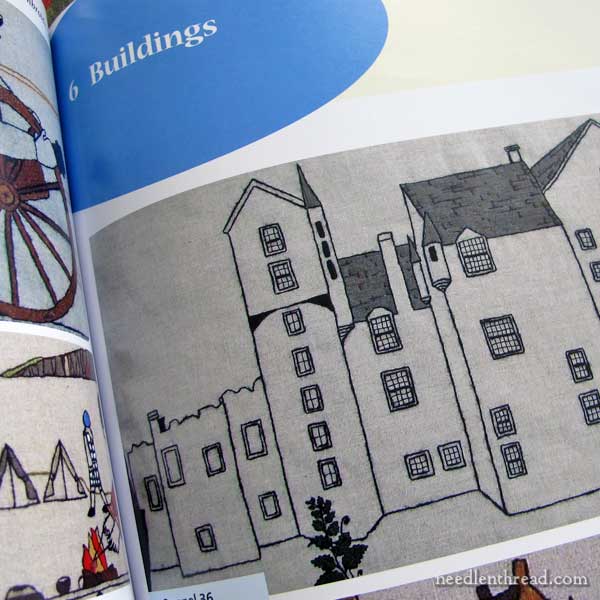
Next up, buildings! From castles to cottages, cityscapes to chimneys, you’ll find all kinds of buildings depicted in the tapestries, along with bridges, fences, doors… everything building-related fits into this section.
If you’d like some inspiration on how to depict your home, your city, your favorite building or bridge in embroidery, you’ll find plenty here!
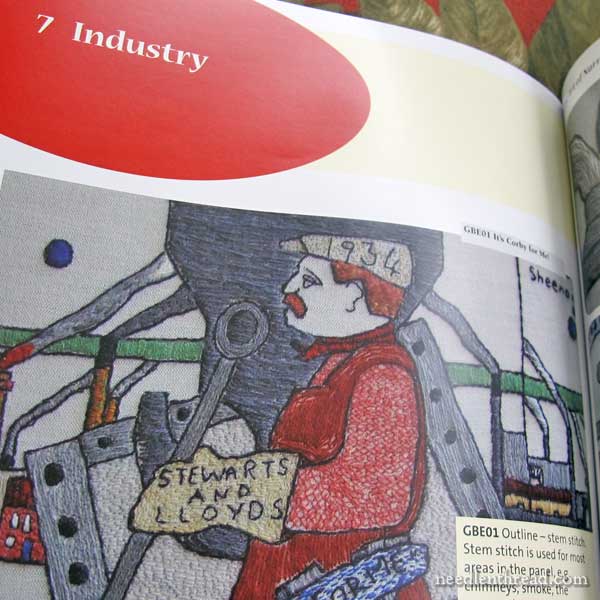
What do people do all day? This is an important part of any human story, so industry has its own section, too. Here, you’ll see people at work in all kinds of spheres of industry. You’ll also see tools of various pursuits – the gardener’s spade, the carpenter’s saw, the gold miner’s pan.
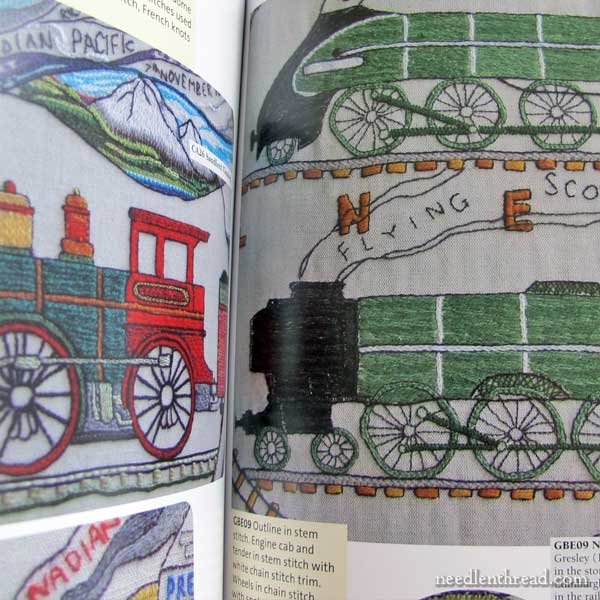
The movement of the masses in related in a section dedicated to vehicles – planes, trains, and the like, from the humble bicycle to the Flying Scotsman.
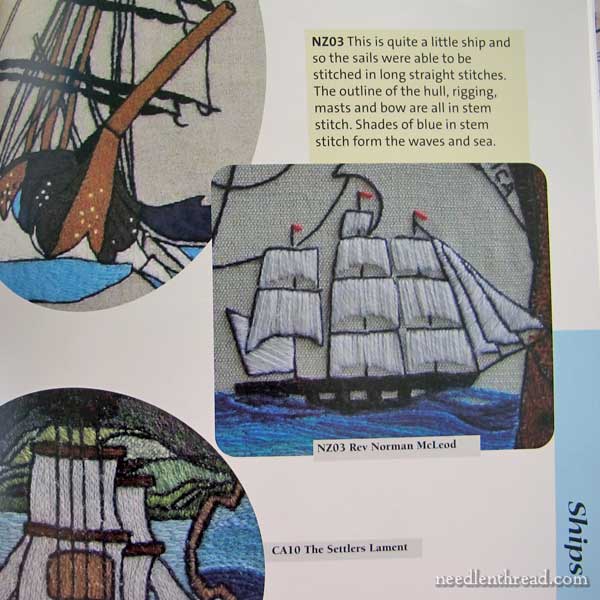
But ships – they get their own section, and I’m glad of that! Glorious, glorious ships, in glorious detail!
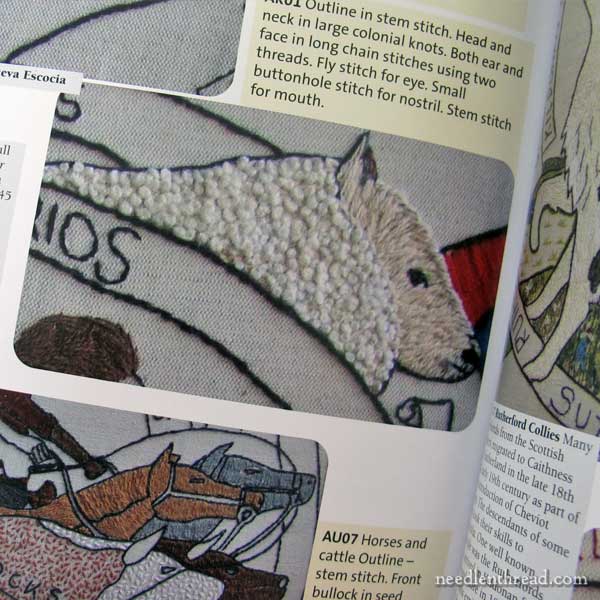
And there is, of course, a section on animals. Sheep figure somewhat prominently, as do horses, and there’s a magnificent beaver in there, too!
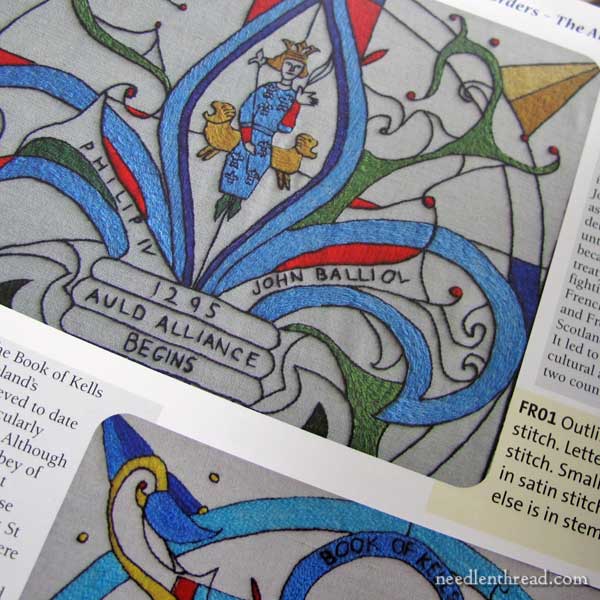
The final category is Borders and Letters, and here you’ll find lots of embroidered ornament and lettering, with all the details on how they were achieved.
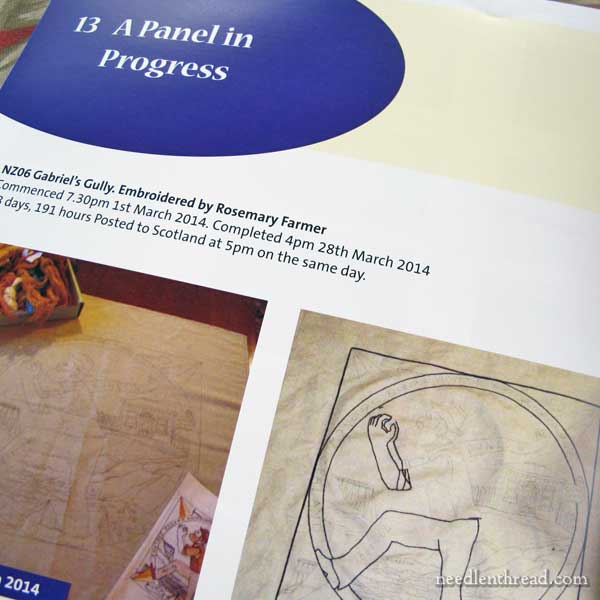
Following the various categories, you’ll find a section that demonstrates the stitching of one panel in progress, as well as a glossary of stitches used.
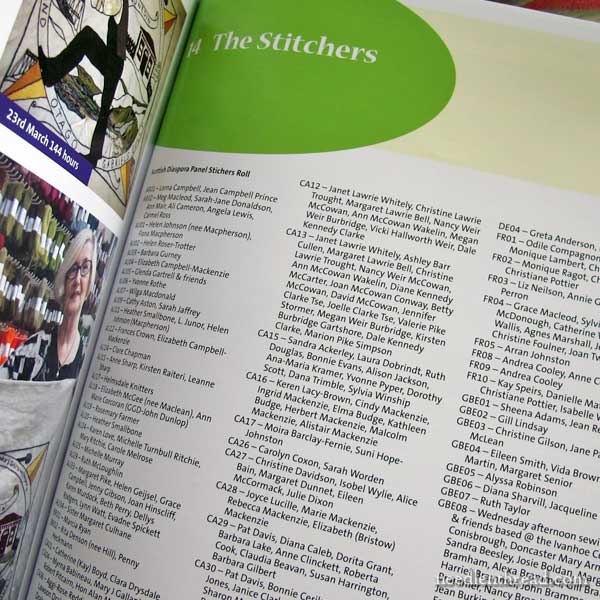
And the book ends, appropriately, with a comprehensive list of the 1000-ish volunteer stitchers from over 30 countries around the world who worked on the various tapestry panels.
Pros & Cons
The pros to owning The Art of Narrative Embroidery are numerous:
1. It’s a wide source for inspiration, especially if you have any interest in narrative embroidery, but also for those who like scenic embroidery, figure embroidery, and the like.
2. There’s really no other book like it.
3. It’s a fantastic way to see close-up details of embroidered tapestry panels.
4. It’s a fascinating history lesson.
5. The embroidery is really beautiful and fun to explore.
The cons:
I can’t really think of any. Perhaps the fact that it’s not widely available and has to be ordered from the UK, but that’s just the way it is – I don’t really see that as a con.
Where to Find
You can find The Art of Narrative Embroidery on the Prestoungrange Arts Festival Boutique website. The book is £12 plus shipping, and outside the UK, shipping is a little steep, at £13, which brings the book to about US$38, with the current currency conversion.
If you have an interest in this type of embroidery, it’s definitely worth the price! You’ll find hours of enjoyment in poring over the images, captions, and details in the book, and you’ll discover that it’s a vast source of inspiration for your own stitching projects.







Wow. WOW! Never saw anything like this. Thank you so much for showing this to us, Mary. Facinating!!
Interesting post.
Here in the Twin Cities, we have the country’s largest community of Hmong. They do the most wonderful narrative embroideries, many (most?) of them of them telling the stories of their escape from Laos/Southeast Asia and their arrival in the US.
The look of these embroideries is very different from what is featured in this book, but the stories are just as compelling. The embroideries are called story cloths.
Links to a couple of sites with more details:
http://www.hmongembroidery.org/embroiderystories.html
https://www.kshs.org/kansapedia/cool-things-hmong-story-cloth/10367
Ah, Mary!
Just when I tell myself that I have all the embroidery books I can POSSIBLY need, you come up with another must-have! This one looks wonderful!
Just toddled off to the Prestongrange Arts Festival Boutique (!) to get a copy of this lovely book. Many of us who stitched the Great Tapestry of Scotland had wished that mention of the types of stitches might have been included in its “big” book, so it’s wonderful to see so many similar solutions in Narrative Embroidery.
I’m in awe of the work y’all did.
I have been to the Parliament building, Aberdeen twice, and Ayr to see the Great Tapestry of Scotland- I guess I am a groupie- and have not seen all the panels yet (except in the book). I also wish for more information about the stitchers, and the groups who worked on it. In my opinion, they are the living history of Scotland.
Dear Mary
the Art of Narrative Embroidery looks so interesting I do like tapestry work telling stories of people, places and events and from the photos the stitching is beautiful. I especially like the sheep and the ships and the apperal of the different figures are lovely and as you say the book looks a wide source of inspiration. Thanks for your review on the Art of Narrative Embroidery and for bringing it to our attention it certainly would be a lovely book to explore all the lovely stitchery and to own.
Regards Anita Simmance
http://scotlandstapestry.com/ertinent to me, & a recent project here in Scotland. I never knew what such a project meant until this, and I look forward to getting a copy of this book.
My typing got muddled up, the web site address may be irrelevant. it should begin with “this is very interesting to me.. “
Ohhhhhh dear….I’m about to order the book…when it arrives, that week will be shot. I won’t be able to keep my nose out of it!
G’day Mary…
and ooh, ahhh and all that. Really wonderful. ‘Loaded to the gills’ eh. Haven’t heard that expression for a long time. Love absolutely everything about what you’ve shown us here.
Thank you,
Cheers, Kath
I’m so delighted for Rosemary Farmer and Maggie Ferguson to read your praiseful review. They certainly deserve it. As soon as we heard their idea here in Prestonpans we knew it would be a winner but they then had to work hundreds of hours researching and editing it all and John Unwin he book designer had to work the page layouts – but what a result. It’s fun and it will be very very inspiring for thousands of embroiderers for many years to come.
I was looking at the gorgeous pictures and noticed something in the third one from the top. “Couched stem stitch”. My inquiring mind immediately wanted to know! But google didn’t have much to say on the matter, except for a pdf file on the Elsberg collection of Egyptian (Arabian) medieval embroideries. One of the figures showed a very bad image of how that stitch is done. Have you heard of this stitch? I admit I wondered why? Stem stitch is certainly not the first stitch I would think to couch. The picture was really bad and I had a difficult telling how it was being couched. My eyes did pick out a very small diagonal slash. I have a reprint of an old needlework dictionary that I will have to dig out of the bookcase to see if this stitch is in it. Any ideas on what you could use this stitch for other than shading the line of the stitch?
Sally-Ann .. you will probably know that although the Great History was designed by AndrewCrummy as well as the two in Prestonmpans, it was an initiative from Sandy MacCall-Smith and his Trust rather than us so alas the brilliant examples there of embroidery are not included in The Narrative Art. We’ve found in Prestonpans that to be able to enjoy the stitches in photographs they have to be enlarged segments rather than the whole which of course is what Rosemary farmer & Maggie Ferguson did.
May the Scottish Renaissance in embroidered community artworks roll on. Already there are a dozen more from NZ to Belgium as well as England, Irealand and Scotland who have been inspired ..
My husband just adores you Mary. He gets all hot and bothered when I say, I just had to spend $$$ because Mary said so.
In truth though, he doesn’t mind at all as long as I am happy, and I have to say I will be very cross if this book doesn’t make me happy – it looks so yummy from this distance and I love narrative works. Of course I ordered it right away, lol.
It is the same here (we are lucky Christina). When I mentioned this book to my husband, he ordered it the same day.
Is this book still available? I am very interested in this subject. Please notify me. Thank you,
Mary Garry
If you contact the resource in the link at the end of the article, where I mention where to find the book, they’ll be able to tell you if it’s still available.